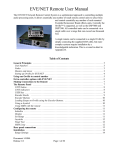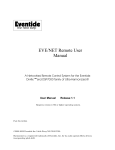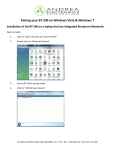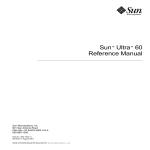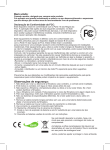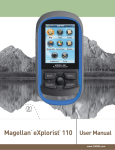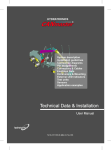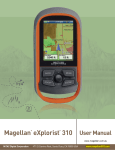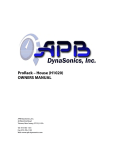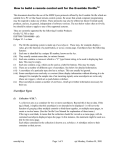Download EVE/NET Remote User Manual
Transcript
EVE/NET Remote User Manual A Networked Remote Control System for the Eventide Orville™ and DSP7000 family of Ultra-Harmonizers® User Manual Release 1.0 Requires version 2.705 or higher operating system. Part No:141044 ©2000 Eventide Inc. Little Ferry NJ 07643 USA Harmonizer is a registered trademark of Eventide, Inc. for its audio special effects devices incorporating pitch shift. This page intentionally left blank. ©2000 Eventide Inc. Little Ferry NJ 07643 USA Harmonizer is a registered trademark of Eventide, Inc. for its audio special effects devices incorporating pitch shift. EVE/NET Remote User Manual The EVE/NET Network Remote Control System is a sophisticated approach to controlling multiple audio processing units. It allows essentially any number of small remote control units to select from and control essentially any number of rack mounted Eventide Harmonizer Brand effects units. Currently the Orville™ is supported, as well as the DSP7000 and DSP7500. All controlled units can be connected via a single cable over a range that can exceed one thousand feet. A single remote can be connected to a single Orville by simply connecting the supplied RJ45 cable, but more complex systems require installation by a knowledgeable technician. This is covered in detail in Appendix B. Table of Contents General Principles . . . . . . . . . . . . . . . . . . . . . . . . . . . . . . . . . . . . . . . . . . . . . . . . . . . . . . . . . . . . . . . . . 3 Unit Numbers . . . . . . . . . . . . . . . . . . . . . . . . . . . . . . . . . . . . . . . . . . . . . . . . . . . . . . . . . . . . . . . . . . . . . 3 Nodes . . . . . . . . . . . . . . . . . . . . . . . . . . . . . . . . . . . . . . . . . . . . . . . . . . . . . . . . . . . . . . . . . . . . . . . . . . . 3 Masters and slaves . . . . . . . . . . . . . . . . . . . . . . . . . . . . . . . . . . . . . . . . . . . . . . . . . . . . . . . . . . . . . . . . 3 Setting up Orville for EVE/NET . . . . . . . . . . . . . . . . . . . . . . . . . . . . . . . . . . . . . . . . . . . . . . . . . . . . . . 4 Using one Orville to control another . . . . . . . . . . . . . . . . . . . . . . . . . . . . . . . . . . . . . . . . . . . . . . . . . 5 Extra controller options with EVE/NET . . . . . . . . . . . . . . . . . . . . . . . . . . . . . . . . . . . . . . . . . . . . . . 6 Making Connections to the Remote . . . . . . . . . . . . . . . . . . . . . . . . . . . . . . . . . . . . . . . . . . . . . . . . . . 7 The Remote Panel . . . . . . . . . . . . . . . . . . . . . . . . . . . . . . . . . . . . . . . . . . . . . . . . . . . . . . . . . . . . . . . . . 7 UNIT button . . . . . . . . . . . . . . . . . . . . . . . . . . . . . . . . . . . . . . . . . . . . . . . . . . . . . . . . . . . . . . . . . . . . . . 8 UNIT indicators . . . . . . . . . . . . . . . . . . . . . . . . . . . . . . . . . . . . . . . . . . . . . . . . . . . . . . . . . . . . . . . . . . . 8 USER key . . . . . . . . . . . . . . . . . . . . . . . . . . . . . . . . . . . . . . . . . . . . . . . . . . . . . . . . . . . . . . . . . . . . . . . . 9 Encoder Knobs . . . . . . . . . . . . . . . . . . . . . . . . . . . . . . . . . . . . . . . . . . . . . . . . . . . . . . . . . . . . . . . . . . . 9 Encoder Buttons . . . . . . . . . . . . . . . . . . . . . . . . . . . . . . . . . . . . . . . . . . . . . . . . . . . . . . . . . . . . . . . . . 10 Loading Setups on Orville using the Encoder Buttons. . . . . . . . . . . . . . . . . . . . . . . . . . . . . . . . . . . 10 Using a Joystick . . . . . . . . . . . . . . . . . . . . . . . . . . . . . . . . . . . . . . . . . . . . . . . . . . . . . . . . . . . . . . . . . 10 Using MIDI with the remote . . . . . . . . . . . . . . . . . . . . . . . . . . . . . . . . . . . . . . . . . . . . . . . . . . . . . . . . 11 Configuring the remote . . . . . . . . . . . . . . . . . . . . . . . . . . . . . . . . . . . . . . . . . . . . . . . . . . . . . . . . . . . 11 Initialize . . . . . . . . . . . . . . . . . . . . . . . . . . . . . . . . . . . . . . . . . . . . . . . . . . . . . . . . . . . . . . . . . . . . . . . . 11 Display . . . . . . . . . . . . . . . . . . . . . . . . . . . . . . . . . . . . . . . . . . . . . . . . . . . . . . . . . . . . . . . . . . . . . . . . . 11 Set Range . . . . . . . . . . . . . . . . . . . . . . . . . . . . . . . . . . . . . . . . . . . . . . . . . . . . . . . . . . . . . . . . . . . . . . . 11 Joysticks . . . . . . . . . . . . . . . . . . . . . . . . . . . . . . . . . . . . . . . . . . . . . . . . . . . . . . . . . . . . . . . . . . . . . . . . 12 Panel Test . . . . . . . . . . . . . . . . . . . . . . . . . . . . . . . . . . . . . . . . . . . . . . . . . . . . . . . . . . . . . . . . . . . . . . 12 MIDI Loop . . . . . . . . . . . . . . . . . . . . . . . . . . . . . . . . . . . . . . . . . . . . . . . . . . . . . . . . . . . . . . . . . . . . . . 12 Rear panel connections . . . . . . . . . . . . . . . . . . . . . . . . . . . . . . . . . . . . . . . . . . . . . . . . . . . . . . . . . . . . 13 Installation . . . . . . . . . . . . . . . . . . . . . . . . . . . . . . . . . . . . . . . . . . . . . . . . . . . . . . . . . . . . . . . . . . . . . . 14 Range Settings . . . . . . . . . . . . . . . . . . . . . . . . . . . . . . . . . . . . . . . . . . . . . . . . . . . . . . . . . . . . . . . . . . . 14 Document 141044 Release 1.0 Page 1 of 20 EVE/NET Remote User Manual Cabling . . . . . . . . . . . . . . . . . . . . . . . . . . . . . . . . . . . . . . . . . . . . . . . . . . . . . . . . . . . . . . . . . . . . . . 14 Termination . . . . . . . . . . . . . . . . . . . . . . . . . . . . . . . . . . . . . . . . . . . . . . . . . . . . . . . . . . . . . . . . . . 15 Power . . . . . . . . . . . . . . . . . . . . . . . . . . . . . . . . . . . . . . . . . . . . . . . . . . . . . . . . . . . . . . . . . . . . . . . 15 Grounding . . . . . . . . . . . . . . . . . . . . . . . . . . . . . . . . . . . . . . . . . . . . . . . . . . . . . . . . . . . . . . . . . . . 16 Document 141044 Release 1.0 Page 2 of 20 EVE/NET Remote User Manual General Principles Ÿ Any EVE/NET system comprises one or more remotes, as well as one or more controlled rack mounted effects units. For readability, these will be referred to as Orvilles in the following text, although they may in fact be members of the DSP7000 family or other units. Ÿ The system may also include various interface devices and power supplies. These are all connected together via a common cable. Ÿ An EVE/NET system comprising one Orville and one remote is known as a simple system. Ü See Appendix B for installation information. Ÿ Any given Orville may be controlled by any number of remotes. Similarily, a given remote can control multiple Orvilles in parallel. Unit Numbers Each controlled effects unit must have a unit number. This is a number from one to four that is used to identify the controlled Orville. More than one Orville may have the same unit number - in this case, when selected by a remote they will be driven in parallel (sent the same commands). In addition, Orvilles with the same unit number may control each other if suitably configured. A remote determines which Orville(s) it will control according to the unit number selected on its panel. Nodes Any functioning Orville, remote or interface adaptor on an EVE/NET network is known as a node and can communicate with any other functioning node on the same network. Masters and slaves A master node is one that can control one or more other nodes. A slave node is one that can be controlled. By definition, a remote is a master, and an Orville can be either or both a master and a slave. Document 141044 Release 1.0 Page 3 of 20 EVE/NET Remote User Manual Setting up Orville for EVE/NET A simple system requires no configuration at either end if both the remote and the Orville are set to their default values. Ü Appendix B for installation information. Ü Orville User Manual. EVE/NET is a sophisticated system, and it is suggested that users do not change ANY settings from their defaults until they are confident that they fully understand its operation. These controls should be viewed as being present in order to enable experts to get the best from the system. To change Orvilles remote settings, hit the SETUP key until you see the EVE/NET label above a softkey. Hit this softkey to bring up the EVE/NET screen shown to the right. Note that this screen is only visible on Orvilles with EVE/NET capability. unit: Allows you to set the unit number of your Orville. This may be between 1 and 4. mode: Determines whether your Orville can be controlled locally (by use of its front panel), remotely or both. This is mainly used to protect the Orville from being changed unexpectedly. If mode is set to local only, the Orville will not be visible to any connected remote, while if mode is set to remote only, the front panel will be locked out. If the Orville is inadvertently set to remote only, front panel control may be restored by holding down the SETUP key for a few seconds. status This indicator shows the status of the Orville’s EVE/NET connection. This will be one of: off-line - the system is either set to local only, or there are no other functioning EVE/NET systems connected. idle - there are other EVE/NET nodes connected, but this Orville is not being controlled by any of them. active - this Orville is currently being controlled by a remote. passive - this is one of multiple Orvilles being controlled by a remote. This means that it has the same unit number as one or more other Orvilles. range This is the approximate maximum total length of the EVE/NET cable. Greater values will cause slower screen updates, whereas smaller values will be less tolerant of installation and configuration problems. All connected nodes must have the same range setting. It is recommended that the default value of 300 ft is used, and that this value not be changed. If one or more units have a different range settings, error message screens will be seen and general performance will be reduced - this is a possible sign that a range value has been set incorrectly. Ü How to set the range for the remote on page 11. Document 141044 Release 1.0 Page 4 of 20 EVE/NET Remote User Manual send This determines what information may be sent over EVE/NET by this Orville. This will be one of: nothing - the Orville is used as an EVE/NET slave device only. keys - key strokes will be sent out and received by any other Orville with the same unit number. This allows one Orville to control another. Ü Using one Orville to control another on page 4. MIDI - any MIDI dumps (SETUP/DUMP/MIDI) will be sent out and received by any other Orville with the same unit number. This allows one Orville to download presets etc. to another. It must also be enabled if the MIDI out sockets on the remote are to be used. keys & MIDI - sends both. Ü Using MIDI with the remote on page 11. load holdoff This determines the time in seconds that one of the encoder buttons must be held down for before a stored setup is loaded. This should be set longer if the encoder buttons are also used as controllers. Ü Ü Extra controller options with EVE/NET on page 4. Loading Setups on Orville using the Encoder Buttons on page 10. versions This displays the hardware/software version numbers of the connected remote. The first is that of the panel assembly, the second that of the encoder assembly. These values will be inconclusive if more than one remote is controlling the Orville. This information is mainly of interest to service personnel. Using one Orville to control another Using EVE/NET, it is possible for one Orville to control another, so that they operate in tandem. For this to make sense, both Orvilles should have the same version of software installed, and any User Presets saved should be the same on each. When this is desired, it is best to set one Orville as the master (sending keys) and the other(s) as slaves (sending nothing). Otherwise much confusion can result. To enable this, do the following: Ÿ set the unit numbers on the Orvilles to the same value. Ÿ set the master Orville to send keys or send keys & MIDI. Ÿ set the slave Orvilles to send none. Ÿ On the master Orville, load the desired presets. This will both make sure that all the Orvilles are running the same preset, and make sure that they are displaying the same screens, i.e. they are in step. Now, the slave Orvilles will follow the master Orville, and, for example, two four channel systems will act as an eight channel system. Document 141044 Release 1.0 Page 5 of 20 EVE/NET Remote User Manual Extra controller options with EVE/NET When an Orville is being controlled by a remote, a number of extra controller options appear on the controller (mod con or assign) setup screens. These can be used to add further remote control options for preset or system parameters. Ü See Orville User Manual for more information on Controllers. The choice of extra controllers will vary with the remote, but usually include: user key the USER key on the remote panel. Ü The remote panel on page 8. joy wheel 1-4 joy button 1-4 Ü joysticks connected to the remote’s joystick connector. buttons on joysticks connected to the remote’s joystick connector. Using a Joystick on page 10. encoder but 1-8 buttons on the remote’s encoder knobs. These may be useful as triggers or extra push buttons. If these are to be used, set load holdoff to a high enough value that stored setups will not be loaded accidentally. Loading Setups on Orville using the Encoder Buttons on page 10. If one of these extra controllers is used to remote control a preset or system parameter, and the system is powered down, and later powered up without a remote being connected, it will be displayed as unavailable until the Orville is next selected by a remote. Document 141044 Release 1.0 Page 6 of 20 EVE/NET Remote User Manual Making Connections to the Remote MIDI out MIDI in EVE/NET Joy Stick At the back of the remote are four connectors, as shown above. Only the EVE/NET connector is required to be connected, the use of rest is optional. Ü See Appendix A for pin out information for these connectors. EVE/NET This requires an 8 pin RJ45 for connection to the EVE/NET network. Power for the remote is also supplied by this connection. For a simple system, all that is required is to use the supplied cable to connect between this connector and the similar one on the back of the Orville. Ü See Appendix B for further installation and EVE/NET connection information Joy Stick This is a 15 pin female D-type connector wired as a standard PC game port connector. It will support a standard PC type joystick (or two joysticks with a suitable adaptor) . Ü See Using a Joystick on page 10. MIDI in This is a 5 pin DIN type connector that can be used as MIDI in, or combined MIDI in and MIDI out. Ü See Using MIDI with the remote on page 11. MIDI out This is a 5 pin DIN type connector that can be used as MIDI out. There is no MIDI thru’ connector. Ü See Using MIDI with the remote on page 11. Document 141044 Release 1.0 Page 7 of 20 EVE/NET Remote User Manual The Remote Panel EVE/NETTM Network Remote Controller The remote panel is similar to that of an Orville, with some repositioning of the existing buttons, and the following additions: 96 88.2 48 44.1 EXT Ÿ UNIT button at left. Ÿ Eight UNIT indicators at left. Ÿ Ÿ USER key at left. Eight encoder knobs at the bottom UNIT 1 PROGRAM SELECT 2 3 BYPASS A/B PARAMETER 4 USER 1 2 3 4 5 6 7 8 9 CXL . 0 - ENT LEVELS SETUP UNIT button This allows the user to select which of the connected Orvilles it will control. It operates by cycling through the unit numbers of the connected Orvilles, and has no effect when either no Orvilles are connected, or when all connected Orvilles have the same unit number. The selected unit number is shown on the indicators below the button. Ü To see how to set an Orville’s unit number, see page 3. It is important to realize that one is selecting a unit number to which one or more Orvilles may be set, rather than selecting a specific Orville. This is why the text sometimes refers to units (meaning one or more Orvilles set to a specific unit number) rather than Orvilles. UNIT indicators These show the connected units (green in right column) and the selected unit number (red in left column). When the system is first powered up, each remote will select the lowest numbered connected unit, or units if more than one Orville is set to the lowest number. If a unit is explicitly selected by using the UNIT button above, this will stay selected, even if it goes off-line (usually because it was powered down or disconnected). This is necessary so that the remote user is made aware that the unit he was controlling is no longer connected. If either no functional Orville is connected (no green indicator lit), or the selected unit has gone off-line (green indicator beside illuminated red indicator is not lit), the off-line screen at the right will be visible. Document 141044 Release 1.0 Page 8 of 20 EVE/NET Remote User Manual USER key This is a general purpose key that can be used as a source for a controller. Ü Extra controller options with EVE/NET on page 3. Encoder Knobs These are general purpose controllers, comprising a knob, an LED indicator ring around it to show the knob position, and a switch which is operated by pushing down on the knob. The knobs are used to control the on-screen parameters, as shown below (knobs numbered from left to right): çknob 5 çknob 6 çknob 7 çknob 8 knob 1à knob 2à knob 3à knob 4à Ÿ The encoder knobs always control the parameters on the displayed screen - they do not need to be assigned before use. Ÿ When you turn a knob, the cursor will move to the parameter that is being changed. This can be distracting if you try to change more than one at a time. Ÿ Once the cursor has moved to a parameter, this parameter is now selected, and can be changed by means of the main wheel or, where appropriate, the numeric keypad. Ÿ Each click on the knob corresponds to the resolution of the parameter, i.e., the amount the parameter will change for one press of the up/down arrows on the right of the numeric keypad. For some parameters, this may be too fine - use the main knob instead. Ü See the Programming Manual to see how to change the resolution of a parameter in a preset. System parameters cannot be changed. Ÿ The indicator ring shows the current setting of the knob, with the bottom left indicator being the minimum possible value, and the bottom right being the maximum value. Since there may be more ‘clicks’ over the entire control range that there are indicator lights, the indicator will not always change for each click of the knob. Ÿ If there is no on-screen parameter corresponding to a given knob, or it is not variable, the indicator ring for that knob will be off. Document 141044 Release 1.0 Page 9 of 20 EVE/NET Remote User Manual Encoder Buttons These may be used for either of two purposes: 1) As general purpose controller buttons. Ü Extra controller options with EVE/NET on page 3. 2) To load setups on the controlled unit. Ü Ü See Orville User Manual for more on setups. See below to see how to set this up.. Loading Setups on Orville using the Encoder Buttons. A complete setup, including presets and routing, on a controlled Orville may be loaded with one press of an encoder button. This is a significant time saver for the busy operator. To save the current setup under an encoder button, press it and hold it until you see the message at right. If you release the button immediately, the operation will be canceled, and the previous setup saved under that button (if any) will be loaded. If instead, you keep it held down longer, you will see the “saving” message, and the setup will then be saved, overwriting any previous setup saved under that button.. When a setup is saved under an encoder button, the names of its presets will be displayed when the button is first pressed. If the button is immediately released, the setup will not be loaded. These setups are saved as normal user setups, given the name “button_1”, “button_2” etc. As a result, they can be deleted, updated or renamed in the normal way. Ü See Orville User Manual to learn about saved setups. The time that you have to hold down the encoder button before getting the “release to load” message is known as the load holdoff time, and is set at the Orville. This should be set long enough so that you do not load setups accidentally by leaning on a button (or a visitor saying “what does this do”..) The default is two seconds. In addition, if you are also using the buttons as a source for a controller, you will want it to be long enough that you can make the distinction between these two operating modes (press and release quickly as a control, press and hold to load). Ü See how to set the load holdoff time on page 4. Using a Joystick A standard PC type joystick can be plugged into the 15 pin socket on the back of the remote. This socket will accept two joysticks, given a suitable cable adaptor. Such joysticks and adaptors are readily available from computer stores. Document 141044 Release 1.0 Page 10 of 20 EVE/NET Remote User Manual These joysticks usually operate in the X and Y axes, and have up to four push buttons. The remote will support two X/Y joysticks and four push buttons as controller inputs. See Appendix A for further information on connecting joysticks. Ü Ü Extra controller options with EVE/NET on page 3. See Orville User Manual for more information on Controllers. It is important to be aware that some features of the more complex joysticks may require extra software (drivers) on the PC to support them - since the remote is not a PC this software will not be useable. As a result, it is best to use a simple analog joystick, or a more complex one that is capable of emulating an analog joystck without extra software. Using MIDI with the remote The MIDI connections on the remote are routed over EVE/NET to the connected units. This means that an external MIDI controller (e.g. keyboard, joystick) can be plugged into the remote, and it will act upon the units that the remote is controlling, just as if it were directly plugged into the Orvilles. Similarily, if send MIDI is set on any of the controlled units, any MIDI messages or dumps sent by them will be available at the remote. Ü Send MIDI on page 3. Configuring the remote The remote normally requires little or no configuration - facilities are provided to adjust screen brightness and contrast, change EVE/NET range ** EVE/NET Remote V1.2 settings, and perform various self-tests. To enter 1: panel test 2: joysticks configuration mode, hold down the UNIT key 3: set range 6: display for about a second until you see the main menu 8: MIDI loop 9: initialize on the right. any other key to continue This menu gives you the following options, which can be selected by pressing the appropriate numeric key as shown on the screen: Initialize This returns all remote settings to their default values. In the event of serious problems, it should be used to return the remote to a known state. Display This allows you to use the knob to change the brightness and contrast settings for the screen, as well as the encoder LED brightness settings. Set Range This allows the maximum operating range (cable length) of the remote to be changed. It is recommended that it NOT be changed, and be left at the default value of 300 ft. All remotes and Orvilles connected to an EVE/NET network MUST have the same range setting, or system performance will be seriously degraded and error messages will be shown. Document 141044 Release 1.0 Page 11 of 20 EVE/NET Remote User Manual If a remote is perpetually off-line and showing repeated error messages as shown by the screen on the right it may be that its range setting is different from others on the network - this can be checked by trying different range settings to see if the problem can be resolved. Hint - the remote or Orville with the longer range setting is most likely to give error messages. Joysticks This displays the values read from the joystick and the names of any joystick buttons pressed. This is useful to confirm joystick functionality, and also to see which button is which. A smoothing value can be set, which is helpful for noisy joysticks. Panel Test This is used to test the switches and LEDs on the panel. The LEDs will light in sequence, and the names of any keys pressed will be displayed on the screen. The value of the wheel will also be displayed. Note: 1) There is no exit from this test - the remote must be powered down and then up to return to normal operation. 2) This does not include the encoders - to test these, hold down an encoder button at power up - their encoder rings will then cycle, and freeze at 12-o’clock when a button is pressed. Power down to return to normal operation. MIDI Loop This test procedure requires that a “loop-back” cable be connected between the remote’s MIDI in and out connectors. It is used to test the MIDI hardware. Document 141044 Release 1.0 Page 12 of 20 Appendix A - Connections Rear panel connections Joystick Connector - 15 pin DIN 1 +5V DC 2 Button 1 3 Joystick 1 - X 4 Ground 5 Ground 11 Joystick 2 - X 6 Joystick 1 - Y 7 Button 2 8 +5V DC 9 +5V DC 10 Button 4 12 do not connect 13 Joystick 2 - Y 14 Button 3 15 do not connect Notes: 1. The 5V DC is not fused and should only be used to power a joy stick or other low power devices. No more than 100mA should be drawn. Damage may result to the remote if this is shorted or connected to any other power source. 2. Buttons are active with a switch closure to ground. 3. The X and Y inputs are suitable for a 10K ohm potentiometer connected between +5V and ground, or may be used for extra switches, with external 10K pull-ups to +5V and closure to ground. MIDI in connector - 5 pin DIN MIDI out connector - 5 pin DIN 1 MIDI TX + 2 MIXI TX 3 no connect 4 MIDI RX + 5 MIDI RX - 1 no connect 2 no connect 3 chassis ground 4 MIDI TX + 5 MIDI TX - EVE/NET Connector - 8 way RJ-45 EVE/NET Function 1 Power + Network T568A White/Green Network Network T568B 10 base-T White/Orange White/Blue Grey 2 Common Green Orange Blue Orange 3 Signal + White/Orange White/Green White/Orange Black 4 Power + Blue Blue 5 Power + White/Blue White/Blue 6 Signal - Orange Green Yellow 7 Common White/Brown White/Brown Blue 8 Common / Chassis Ground Brown Brown Brown Document 141044 Release 1.0 Page 13 of 20 Telephone Red Orange Green Appendix B - Installation This section is intended for for qualified technicians involved in installing EVE/NET systems. The information it contains is not required in order to understand the operation or use of the system. Installation The EVE/NET system is derived from a well-proven networking system designed for industrial use, with over ten million systems installed. As a result it is very rugged and tolerant of faults and poor configuration. Notwithstanding the above, the configuration and subsequent successful operation of an EVE/NET system is assisted by understanding the following parameters. 1. 2. 3. 4. 5. Range Settings Cabling Termination Power Grounding Range Settings Each EVE/NET peripheral has a range setting that governs both the maximum cable length and the communication speed. These are: 50 ft (fastest) and 1200 ft (slowest). The default and recommended setting is 300 ft. At slower range settings, the screen update time will be more noticeable, at faster range settings, correct cabling and configuration is more important. Note that the maximum distance is governed more by the speed of light than by the cable quality, so the maximum length for a given setting should not be exceeded. All systems connected by the same cable must have the same range setting. Non-communication, permanent off-line indications or frequent error reports may be a sign of incorrect range settings. Cabling There are two issues to consider when cabling an EVE/NET network: i. Topology - this is the way the EVE/NET nodes are connected. (A node is either a remote console or an EVE/NET equipped effects processor.) The nodes must be connected in a “daisy-chain” pattern, so that the cable goes from A to B to C to D etc. They may not be connected in a “star” pattern, where the cable goes from A to B and A to C and A to D, etc. ii. Cable Type - EVE/NET requires eight way RJ-45 type cabling and connectors. All eight pins must be connected to the same numbered pins on each connector. Telephone-type T-adaptors may be used as long as the common plug is connected directly to the EVE/NET socket. For short runs or temporary hookups, RJ-45 type telephone leads can be used. For long runs, especially when the total length approaches the “range” limit (see below), CAT-5 Document 141044 Release 1.0 Page 14 of 20 Appendix B - Installation network grade cable should be used. This should be wired to the same standards as a 10 MB/s Ethernet system. Ü See Appendix A for pin connections, color codes etc. NOTE (1): An EVE/NET system must not be connected to any other networking system, as damage and incorrect operation may result. NOTE (2): When using manufactured leads, be sure to check that the connections are not reversed (as in a “cross-over” cable). Hold the two ends side by side, facing the same way, and confirm that the color order of the wires is the same. Termination The first and last nodes on the “daisy-chain” must have termination resistors connected. All others must have termination resistors disconnected. This is done by installing or removing jumpers on the printed circuit boards (see Appendix C for details). As delivered, the default setting is for termination to be applied on all nodes - this will have to be changed for systems using more than two nodes. The EVE/NET system will usually tolerate some redundant or missing termination, but the rule should be followed for permanent installations and greatest reliability. Power Since the remote consoles have their power supplied down the EVE/NET cable, this requires some consideration. A single Orville can power a single remote console, while a DSP7000/7500 requires an external power supply. (Note that early Orvilles, identifiable by having only two transformer mounting holes on the right hand side panel rather than the three on later systems, also require an external power supply.) Allowing multiple Orvilles to power the same line in effect connects their power supply outputs in parallel, and can cause overheating or other damage. Thus a simple system involving a single Orville and a single console may use just the supplied RJ45 cable and default jumpering. A more complex configuration must be designed rather than just hooked up. Power supplied from an Orville may be disconnected by removing the 1A fuse near the RJ45 socket. Eventide can supply a small power adaptor that is capable of powering two remote consoles, and has useful power and termination options. This is provided as part of the DSP7x00 Installation Kit and is also available separately. Ü See the sample layouts in Appendix C for examples. Document 141044 Release 1.0 Page 15 of 20 Appendix B - Installation Grounding Since the remote consoles are powered down the EVE/NET cable, it follows that their electrical grounds are also connected down this cable. As connected Orvilles and DSP7x00s will usually also be grounded, it follows that care must be taken to avoid ground loops when more than one effects unit is being controlled. The EVE/NET circuitry in each effects unit is opto-isolated, allowing ground connections to be removed. This is done by the use of printed circuit board jumpers. Ü See Appendix C for board configuration details. Similarily, for reasons of electrical safety and RFI reduction, remote systems require chassis ground connections. To avoid ground loops, this connection should only be made at one place. Ü See the sample layouts in Appendix C for examples. Document 141044 Release 1.0 Page 16 of 20 EVE/NET Remote User Manual - Index setting for Orville, 4 setting for remote, 11 C cross-over cable, 15 E encoder buttons, 10 buttons as controllers, 6 knobs, 9 G Grounding, 16 J joy stick connector, 7 testing, 12 using, 10 L load holdoff, 10 setting on Orville, 5 M MIDI connector, 7 sending from Orville, 5 test procedure, 12 using with the remote, 11 mode setting on Orville, 4 N node, 4 definition, 3 same range setting, 4 nodes, 15 O off-line screen, 8 R range Document 141044 Release 1.0 Page 17 of 20 S simple system, 4, 7, 15 definition, 3 T Termination, 15 U unit button, 8 indicators, 8 unit number, 4 definition, 3 same, 4 selection from remote, 8 USER key, 9 Appendix C - Configuration Examples T T Orville 1 A simple system - no configuration required T T DSP 7x00 1 Power Supply A simple DSP7x00 system - no configuration required. Fuse must always be out in DSP7x00 T T 1 2 Orville Power Supply T T 1 Key T Terminator installed T Terminator not installed Release 1.0 Fuse installed Fuse not not installed Page 18 of 20 Orville/7x00 T Orville/7x00 T Orville T T piece Ground jumper installed Ground jumper removed Appendix C - Hardware Configuration In order to configure an EVE/NET node you must first identify it. Orvilles and 7000/7500’s will be one of two types: 1) With RJ45 EVE/NET socket mounted on motherboard. 2) With RJ45 EVE/NET socket mounted on plug-in option card. Motherboard-type configuration RJ45 J2802 J2803 D2800 Battery F2800 Expansion Socket (unused) T Jumper installed at J2803 F2800 installed T Jumper NOT installed at J2803 F2800 NOT installed Jumper installed at J2802 Jumper NOT installed at J2802 Factory Defaults: Orville DSP7000/7500 Release 1.0 T T Page 19 of 20 D2800 shows EVE/NET power Appendix C - Hardware Configuration Option board configuration TERMINATOR RJ45 J2 D26 J3 F1 D24 D21 Components on left side of board installed for Orville, omitted for DSP7000/7500. T Jumper installed at J2 F1 installed T Jumper NOT installed at J2 F1 NOT installed Jumper installed at J3 Jumper NOT installed at J3 Factory Defaults: Orville DSP7000/7500 Release 1.0 T T Page 20 of 20 D21 lit if offline D24 lit if active D26 shows EVE/NET power






















